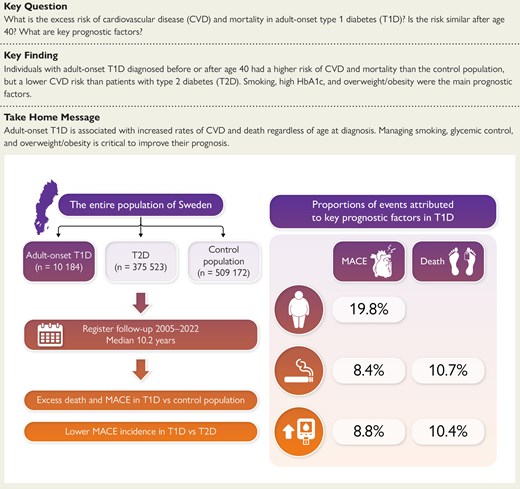2025-05-14 カロリンスカ研究所(KI)
<関連情報>
- https://news.ki.se/adult-onset-type-1-diabetes-increases-risk-of-cardiovascular-disease-and-death
- https://academic.oup.com/eurheartj/advance-article/doi/10.1093/eurheartj/ehaf304/8127980
成人発症1型糖尿病:主要な心血管イベントと死亡率の予測因子 Adult-onset type 1 diabetes: predictors of major cardiovascular events and mortality
Yuxia Wei , Tomas Andersson , Tiinamaija Tuomi , Thomas Nyström , Sofia Carlsson
European Heart Journal Published:14 May 2025
DOI:https://doi.org/10.1093/eurheartj/ehaf304

Structured Graphical Abstract
Abstract
Background and Aims
The prognosis of adult-onset type 1 diabetes (T1D) and prognostic factors are sparsely investigated. This study assessed mortality, major adverse cardiovascular events (MACE), and prognostic factors in adult-onset T1D, particularly focusing on those diagnosed at age ≥40.
Methods
Participants were people diagnosed with adult-onset T1D (n = 10 184) or type 2 diabetes (T2D, n = 375 523) in 2001–20 from the Swedish National Diabetes Register and 509 172 population controls from the Total Population Register, followed until 2022. Hazard ratios (HR) and population attributable risk fraction (PAR%) were estimated.
Results
People with T1D had higher incidence of MACE (HR 1.30 [95% confidence interval 1.17, 1.45]), all-cause mortality (1.71 [1.60, 1.84]), and mortality from cardiovascular or non-cardiovascular diseases, cancer, or infection than population controls. They had lower MACE incidence (0.67 [0.60, 0.75]) and higher mortality from diabetic coma or ketoacidosis (7.04 [4.54, 10.9]) than people with T2D. Smoking (PAR% 10.7%) and glycated haemoglobin (HbA1c) ≥ 53 mmol/mol (10.4%) accounted for most deaths while overweight/obesity (19.8%), smoking (8.4%), and high HbA1c (8.8%) accounted for most MACE events in T1D. Results were similar for T1D diagnosed at age ≥40, although they had lower insulin pump use and higher HbA1c than people diagnosed earlier.
Conclusions
Adult-onset T1D carries excess risk of death and MACE compared with population controls but less MACE risk than T2D. Individuals diagnosed after age 40 had similar excess risk and poorer glycaemic control than those diagnosed earlier, underscoring the need for improved management. Key prognostic factors were smoking, poor glycaemic control, and overweight/obesity.


